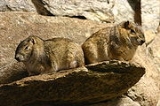
Kerodon
Encyclopedia
The genus Kerodon contains two species of South America
n rock cavies related to capybara
s.
is 76–77 days with 1-3 young born to females. Metabolic rate is 0.45 ml-O2/(g h) (Rowe and Honeycutt, 2003). It is found in rocky habitat in arid regions.
and the maras, members of the genus Kerodon are highly social (Rowe and Honeycutt, 2003). Kerodon, like its relative the capybara, is polygynous
with males forming harem
s.
along with the guinea pig
s and other cavies. Molecular
results have consistently suggested that Kerodon is most closely related to the capybara
, and that the two evolved from within the Caviidae
(Rowe and Honeycutt, 2002). This led Woods and Kilpatrick (2005) to unite the two into the subfamily Hydrochoerinae
within the Caviidae. Using a molecular clock
approach, Opazo (2005) suggested that Kerodon diverged from Hydrochoerus (the capybara) in the late Middle Miocene
.
South America
South America is a continent situated in the Western Hemisphere, mostly in the Southern Hemisphere, with a relatively small portion in the Northern Hemisphere. The continent is also considered a subcontinent of the Americas. It is bordered on the west by the Pacific Ocean and on the north and east...
n rock cavies related to capybara
Capybara
The capybara , also known as capivara in Portuguese, and capibara, chigüire in Venezuela, Colombia, and Ecuador ronsoco in Peru, chigüiro, and carpincho in Spanish, is the largest living rodent in the world. Its closest relatives are agouti, chinchillas, coyphillas, and guinea pigs...
s.
Characteristics
Adults weigh about 800 grams. Gestation periodGestation period
For mammals the gestation period is the time in which a fetus develops, beginning with fertilization and ending at birth. The duration of this period varies between species.-Duration:...
is 76–77 days with 1-3 young born to females. Metabolic rate is 0.45 ml-O2/(g h) (Rowe and Honeycutt, 2003). It is found in rocky habitat in arid regions.
Behavior
Like their relatives, the capybaraCapybara
The capybara , also known as capivara in Portuguese, and capibara, chigüire in Venezuela, Colombia, and Ecuador ronsoco in Peru, chigüiro, and carpincho in Spanish, is the largest living rodent in the world. Its closest relatives are agouti, chinchillas, coyphillas, and guinea pigs...
and the maras, members of the genus Kerodon are highly social (Rowe and Honeycutt, 2003). Kerodon, like its relative the capybara, is polygynous
Polygyny
Polygyny is a form of marriage in which a man has two or more wives at the same time. In countries where the practice is illegal, the man is referred to as a bigamist or a polygamist...
with males forming harem
Harem
Harem refers to the sphere of women in what is usually a polygynous household and their enclosed quarters which are forbidden to men...
s.
Classification
Traditionally the genus Kerodon has been considered a member of the subfamily CaviinaeCaviinae
Caviinae is a subfamily uniting all living members of the family Caviidae with the exception of the maras, capybaras and Kerodon. The subfamily traditionally contained the guinea pig-like forms along with the cursorially adapted Kerodon...
along with the guinea pig
Guinea pig
The guinea pig , also called the cavy, is a species of rodent belonging to the family Caviidae and the genus Cavia. Despite their common name, these animals are not in the pig family, nor are they from Guinea...
s and other cavies. Molecular
Molecular phylogeny
Molecular phylogenetics is the analysis of hereditary molecular differences, mainly in DNA sequences, to gain information on an organism's evolutionary relationships. The result of a molecular phylogenetic analysis is expressed in a phylogenetic tree...
results have consistently suggested that Kerodon is most closely related to the capybara
Capybara
The capybara , also known as capivara in Portuguese, and capibara, chigüire in Venezuela, Colombia, and Ecuador ronsoco in Peru, chigüiro, and carpincho in Spanish, is the largest living rodent in the world. Its closest relatives are agouti, chinchillas, coyphillas, and guinea pigs...
, and that the two evolved from within the Caviidae
Caviidae
The cavy family is a family of rodents native to South America, and including the domestic guinea pig, wild cavies, and the capybara, among other animals...
(Rowe and Honeycutt, 2002). This led Woods and Kilpatrick (2005) to unite the two into the subfamily Hydrochoerinae
Hydrochoerinae
Hydrochoerinae is a subfamily of Caviidae, consisting of two living genera, Hydrochoerus, the capybaras, and Kerodon, the rock cavies. In addition, a number of extinct genera related to capybaras should also be placed in this subfamily...
within the Caviidae. Using a molecular clock
Molecular clock
The molecular clock is a technique in molecular evolution that uses fossil constraints and rates of molecular change to deduce the time in geologic history when two species or other taxa diverged. It is used to estimate the time of occurrence of events called speciation or radiation...
approach, Opazo (2005) suggested that Kerodon diverged from Hydrochoerus (the capybara) in the late Middle Miocene
Miocene
The Miocene is a geological epoch of the Neogene Period and extends from about . The Miocene was named by Sir Charles Lyell. Its name comes from the Greek words and and means "less recent" because it has 18% fewer modern sea invertebrates than the Pliocene. The Miocene follows the Oligocene...
.
Species
- Genus Kerodon
- Kerodon acrobata - Climbing Cavy
- Kerodon rupestris - Rock Cavy

